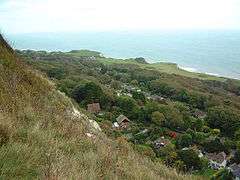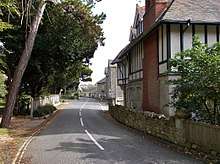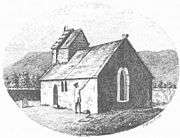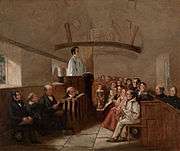St Lawrence, Isle of Wight
St Lawrence is a village on the south side of the Isle of Wight, in southern England. It is located to the west of Ventnor and many consider it a part of that town. St Lawrence is situated on the Undercliff, and is subject to frequent landslips. The village is a 1 1⁄2-mile (2.4 km) strip along the coast next to the English Channel,[1] nearby bays include: Woody Bay, Mount Bay and Orchard Bay.[2] The area of the village is around 329 acres (133 ha) in size.[3]
| St Lawrence | |
|---|---|
 The Undercliff area of St Lawrence | |
 St Lawrence Location within the Isle of Wight | |
| Area | 0.51 sq mi (1.3 km2) |
| OS grid reference | SZ562775 |
| Unitary authority | |
| Ceremonial county | |
| Region | |
| Country | England |
| Sovereign state | United Kingdom |
| Post town | VENTNOR |
| Postcode district | PO38 |
| Dialling code | 01983 |
| Police | Hampshire |
| Fire | Isle of Wight |
| Ambulance | Isle of Wight |
| UK Parliament | |
History
St. Lawrence is much older than Ventnor dating back to at least the Middle Ages. The Old Church of St. Lawrence dates from the 12th century. When first built it was only 20 feet long and 12 feet wide,[1] considered at the time to be the smallest church in England. In 1842 it was lengthened by the addition of a ten-foot chancel.[4] Although there are undoubtedly smaller chapels including the tiny church at Les Vauxbelets on Guernsey, this arguably remains the smallest to be built as a parish church — although this role has long since been supplanted by a larger church in the village.
The old church has a 15th-century baptismal font - a stoup that is about 500 years old and a series of 18th-century hat pegs. The piscina niche is almost the same age as the church. The church was refurbished in 1926-7.[5] A larger church, St Lawrence's Church, St Lawrence, is situated 200 yards (180 m) away from the Old Church dates from the 19th century.[5] It also has a 17th-century altar and a chest that dates from 1612.


In the 1870s the village was described in the Imperial Gazetteer of England and Wales as consisting of "ivy mantled thatched cottages, with orchards" with many Juniper trees nearby.[1]
During World War II the village was home to RAF St Lawrence. Originally a temporary base for RAF Ventnor and RAF Thorney Island, by 1942 it was a fully active radar base in its own right. The base had two 120-foot-tall (37 m) masts approximately 200 yards apart.[7] The base ceased operations in 1947 and in 1994 a memorial plaque was placed at the site.[8]
William Spindler

St Lawrence was in the nineteenth century the subject of an ambitious plan by a German developer, named William Spindler (who had made his fortune as a chemist in Berlin), to develop St Lawrence as a resort to rival Ventnor. He lived on the Isle of Wight from 1881 to his death in 1889 and is buried in Whitwell. During his time in St. Lawrence, he had an enormous influence there and on the surrounding areas. He possibly alienated local opinion with a series of "improving pamphlets" criticising local perceived laziness. His legacy has been a number of grand Victorian houses, often semi-derelict and half hidden by woodland. Perhaps his most noticeable memorials are several huge pieces of masonry in Binnel Bay, which once formed a harbour which is all but inaccessible from the land. These have fallen into titanic ruins and are known locally as "Spindler's Follies".[9]
Amenities
The village has a post office and two churches. There was a glassworks styled as Isle of Wight Glass by the Old Park Hotel in St. Lawrence but this is now closed. Nearby was the site of a Tropical Bird Park, now also closed.
Close to the newer church is the site of the Rare Breeds Park, which closed while the A3055 road was closed to the west of the village due to a landslip.
Transport
It is linked to other parts of the Island by Wightbus bus route 16, serving Ventnor and Shanklin and intermediate villages.[10] This service was withdrawn along with all other wight bus services in 2011. The village was served by a two-hourly service by Southern vectis' route 6 between Ventnor and Newport until a landslip between St Lawrence and Niton in 2014. Since February 2014 Southern Vectis route 6 terminates at Ventnor Botanic Gardens with a more limited morning service between St Lawrence village and Ventnor.
References
 "The Church at St Lawrence", engraving by Richard Godfrey of Long Acre, c. 1780. ^
"The Church at St Lawrence", engraving by Richard Godfrey of Long Acre, c. 1780. ^ R. H. C. Ubsdell. "A sermon at St. Lawrence's church, Isle of Wight"
R. H. C. Ubsdell. "A sermon at St. Lawrence's church, Isle of Wight"
- "St Lawrence Hampshire". A vision of Britain Through Time. Great Britain Historical GIS, University of Portsmouth. Retrieved 3 September 2018.
- Google (3 September 2018). "St Lawrence, Isle of Wight" (Map). Google Maps. Google.
- "St Lawrence area acres". A vision of Britain Through Time. Great Britain Historical GIS, University of Portsmouth. Retrieved 3 September 2018.
- "Parishes: St Lawrence". British History Online.
- "Old Church of St Lawrence". visitisleofwight.co.uk. Retrieved 3 September 2018.
- "St Lawrence Population". A vision of Britain Through Time. Great Britain Historical GIS, University of Portsmouth. Retrieved 3 September 2018.
- "RAF St. Lawrence - Chain Home Remote Reserve". Subterranea Britannica. 2004.
- "RAF St Lawrence Radar Station". Imperial War Museum.
- Lake House Design: William Spindler
- "Traveline - Wightbus route 16". traveline.org.uk. 2008. Retrieved 4 May 2008.
Notes
- 1.^ Published in Worsley, Sir Richard, History of the Isle of Wight, London, 1781
External links
| Wikimedia Commons has media related to St Lawrence, Isle of Wight. |